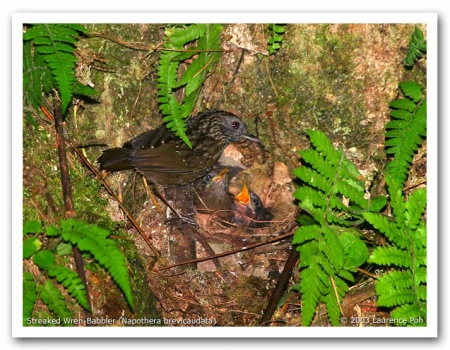Alternative names: Short-tailed Wren-Babbler; Streak-throated Wren-Babbler
- Gypsophila brevicaudata
Turdinus brevicaudatus
Napothera brevicaudata
Identification
12 - 17cm (4¾-6¾ in). A smallish, short-tailed babbler:
- Grey-brown above with coarse blackish scales
- Whitish shaft-streaks on crown
- Pale grey face (no supercilium)
- Broad grey-brown streaks on white throat and upper breast
- Unmarked rusty-tinged lower underparts
Females are more rufous, juveniles are uniform dark brown
Variations
The different subspecies differ in colour tones, the nominate having rufous underparts, others like stevensi or leucosticta more greyish-brown (see taxonomy).
Distribution
Found from northeast India to Burma, south China (Yunnan to Guangxi), Thailand, Laos, Vietnam, Cambodia and peninsular Malaysia.
Locally fairly common.
Taxonomy
This is a polytypic species[1] consisting of 8 subspecies.
Subspecies
- G. b. striata:
- Hill forests of southern Assam (south of the Brahmaputra) to southwestern Myanmar
- G. b. venningi:
- G. b. brevicaudata:
- Northern Thailand south to southern Myanmar
- G. b. stevensi:
- Southern China (southwestern Guangxi) and northern Indochina
- G. b. griseigularis:
- G. b. proxima:
- G. b. rufivventer:
- Southern Vietnam (Langbian Plateau)
- G. b. leucosticta:
- Thai-Malay Peninsula
Subspecies venningi is not recognised by all authorities[2]
Has been thought to be conspecific with Mountain Wren-Babbler or to form a superspecies with it.
Sometimes placed in genus Napothera.
Habitat
Broadleaf evergreen forest. Often seen near rocky outcrops. Found at 300 - 2100m in India, above 610m in Malaysia and up to 1830m in rest of range.
Behaviour
Diet
Feeds on insects, grubs and small molluscs.
Usually seen in pairs or small groups. Difficult to see as it forages near the ground in dense vegetation or around rocks and boulders.
Breeding
Breeding season from January to July. The nest may be a cup (see picture), a semi-dome or a dome made of dead leaves, dead brackesn, grasses, rootlets and other material. It's placed on the ground, between boulders or in a hollow pile of boulders or in a mossy bank. Lays 2 - 4 eggs.
Movements
Resident species.
References
- Clements, J. F., T. S. Schulenberg, M. J. Iliff, S. M. Billerman, T. A. Fredericks, J. A. Gerbracht, D. Lepage, B. L. Sullivan, and C. L. Wood. 2021. The eBird/Clements checklist of Birds of the World: v2021. Downloaded from https://www.birds.cornell.edu/clementschecklist/download/
- Avibase
- Del Hoyo, J, A Elliott, and D Christie, eds. 2007. Handbook of the Birds of the World. Volume 12: Picathartes to Tits and Chickadees. Barcelona: Lynx Edicions. ISBN 978-8496553422
- Rasmussen, PC and JC Anderton. 2005. Birds of South Asia: The Ripley Guide. Barcelona: Lynx Edicions. ISBN 978-8487334672
Recommended Citation
- BirdForum Opus contributors. (2024) Streaked Wren-Babbler. In: BirdForum, the forum for wild birds and birding. Retrieved 27 April 2024 from https://www.birdforum.net/opus/Streaked_Wren-Babbler
External Links
Search by scientific name Gypsophila brevicaudata:
Search by common name:
GSearch checked for 2020 platform.





